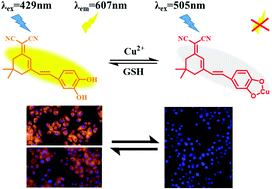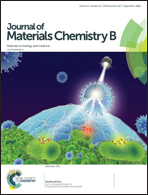A new colorimetric and fluorescent probe with a large stokes shift for rapid and specific detection of biothiols and its application in living cells†
Abstract
In this work, a new reversible colorimetric and fluorescent probe for sequential recognition of copper ions and biothiols is synthesized easily. Based on the chelation-enhanced fluorescence quenching (CHEQ) effect, this probe shows high sensitivity and selectivity towards Cu2+, which can be detected by the naked eye. And this experimental phenomenon can also be realised upon addition of biothiols, restoring their initial fluorescence intensity. This probe also features a very high response speed (less than 5 seconds) and a large stokes shift (178 nm) toward Cu2+ and biothiols. Moreover, the detection limit for Cu2+ and biothiols is as low as 7.34 nM and 10.3 nM, respectively. Additionally, this ON–OFF–ON-type fluorescence recognition cycle can be repeated more than 5 times by addition of Cu2+ and biothiols in turn. Particularly, this 1–Cu2+ ensemble is further successfully applied for GSH detection in living cells.



 Please wait while we load your content...
Please wait while we load your content...